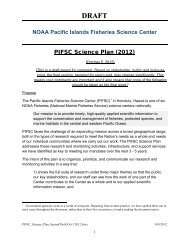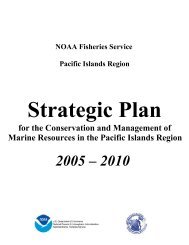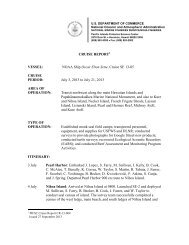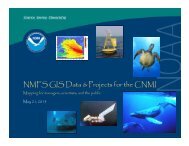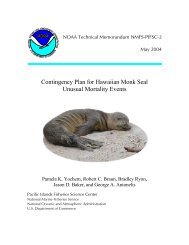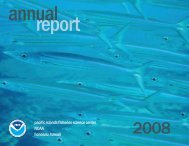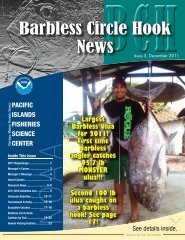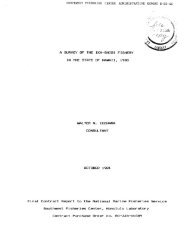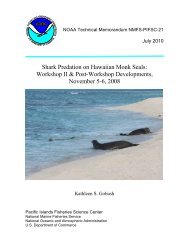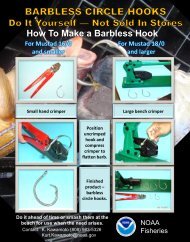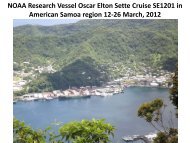Relationship of zooplankton emergence, manta ray abundance and ...
Relationship of zooplankton emergence, manta ray abundance and ...
Relationship of zooplankton emergence, manta ray abundance and ...
Create successful ePaper yourself
Turn your PDF publications into a flip-book with our unique Google optimized e-Paper software.
<strong>Relationship</strong> <strong>of</strong> <strong>zooplankton</strong> <strong>emergence</strong>, <strong>manta</strong><br />
<strong>ray</strong> <strong>abundance</strong> <strong>and</strong> SCUBA diver usage<br />
Kona Hawaii<br />
By, Kara Osada<br />
UHH masters thesis<br />
Tropical Conservation Biology <strong>and</strong> Environmental Science
What brings me here today<br />
The Manta Rays!!!
• Manta <strong>ray</strong> dives<br />
contribute an estimated<br />
2.4 million dollars to<br />
Konas economy<br />
annually.<br />
• The <strong>manta</strong> <strong>ray</strong> night<br />
dive depends on the<br />
<strong>zooplankton</strong> the <strong>manta</strong><br />
<strong>ray</strong>s come in to feed<br />
upon<br />
• Held over a rubble/<br />
s<strong>and</strong>/coral area
Manta Rays<br />
• Little is known about <strong>manta</strong> <strong>ray</strong>s but new<br />
research has found seasonal <strong>abundance</strong><br />
increases <strong>of</strong> <strong>manta</strong> <strong>ray</strong>s in association with high<br />
productivity areas (Dewar et al 2008; Luiz et al. 2009)<br />
• In other words, areas <strong>of</strong> high food<br />
concentrations will have high <strong>manta</strong> <strong>ray</strong><br />
numbers.<br />
• Thus as <strong>manta</strong> <strong>ray</strong>s are important economic<br />
benefit for Hawaii, knowing about <strong>and</strong> protecting<br />
their food source – <strong>zooplankton</strong> - seems key
Reefs <strong>and</strong> Zooplankton<br />
• In the past <strong>zooplankton</strong> were considered<br />
insignificant contributors to coral reef foodwebs<br />
(Odum <strong>and</strong> Odum, 1955; Tr<strong>and</strong>er <strong>and</strong> George, 1972; Johannes, 1974).<br />
• More recent studies have demonstrated the<br />
importance <strong>of</strong> <strong>zooplankton</strong> to reef nutrition <strong>and</strong><br />
idealized <strong>zooplankton</strong> as a source <strong>of</strong> increasing<br />
nutrient revenues for the reef ecosystem as a<br />
whole (Emery, 1968; Rothans <strong>and</strong> Miller, 1991; Pinnegar <strong>and</strong> Polunin, 2005)<br />
• What we now underst<strong>and</strong> is in many areas some<br />
<strong>zooplankton</strong> <strong>of</strong>ten thought to be oceanic in<br />
nature actually reside within the benthic<br />
community (Sale et al., 1976; Porter <strong>and</strong> Porter, 1977; Alldredge <strong>and</strong> King, 1977; Sale<br />
et al. 1978; Hobson <strong>and</strong> Chess 1979; Walter et al., 1981; Jacoby <strong>and</strong> Greenwood, 1989).
Why does this matter for us?<br />
– Manta <strong>ray</strong>s come into the<br />
night dive area to feed on<br />
the <strong>zooplankton</strong> attracted<br />
to divers lights<br />
– Zooplankton might be<br />
originating from the<br />
substrate the divers are<br />
sitting on<br />
– This has larger<br />
implications…
Diver sustainability<br />
• Research has shown that if SCUBA diver numbers<br />
exceed 5,000 to 6,000 divers annual a reduction in coral<br />
growth is expected (Hawkins et al., 1997; Jameson et al., 1999; Tatalos <strong>and</strong> Austin,<br />
2001; Zakai <strong>and</strong> Chadwick-Furman, 2002)<br />
• Zooplankton research has found that increased<br />
<strong>emergence</strong> rates are found from increased substrate<br />
complexity - such as coral reef communities (Sale et al.,<br />
1976; Porter <strong>and</strong> Porter, 1977; Alldredge <strong>and</strong> King, 1977; Sale et al., 1978;<br />
Hobson <strong>and</strong> Chess, 1979 Walter et al., 1981; Jacoby <strong>and</strong> Greenwood,<br />
1989).<br />
• An estimated 20,000 to 25,000 divers dive on the dive<br />
site called Garden Eel Cove annual – the location <strong>of</strong> the<br />
<strong>manta</strong> <strong>ray</strong> night dive
Zooplankton<br />
• Collected three ways<br />
– Emergence nets<br />
– Surface Tows<br />
– Vertical Tows
Study sites<br />
Makako<br />
Hoona
Zooplankton
Average (±SD) number <strong>of</strong> individual <strong>zooplankton</strong><br />
1800<br />
1600<br />
1400<br />
Makako<br />
Hoona<br />
Num <strong>of</strong> ind per 0.25 m2<br />
1200<br />
1000<br />
800<br />
600<br />
400<br />
200<br />
0<br />
-200<br />
Apr<br />
15<br />
Apr<br />
30<br />
May<br />
14<br />
May<br />
27<br />
Jun<br />
13<br />
Jun<br />
29<br />
Jul<br />
13<br />
Jul<br />
28<br />
Sample Date<br />
Aug<br />
11<br />
Sep<br />
09<br />
Oct<br />
09<br />
Oct<br />
24<br />
Nov<br />
08
60<br />
50<br />
Average (±SD) number <strong>of</strong> <strong>zooplankton</strong><br />
species<br />
Makako Hoona<br />
Num <strong>of</strong> Ind per 0.25m2<br />
40<br />
30<br />
20<br />
10<br />
0<br />
Apr<br />
15<br />
Apr<br />
30<br />
May<br />
14<br />
May<br />
27<br />
Jun<br />
13<br />
Jun<br />
29<br />
Jul<br />
13<br />
Jul<br />
28<br />
Aug<br />
11<br />
Sep<br />
09<br />
Oct<br />
09<br />
Oct<br />
24<br />
Nov<br />
08<br />
Sample Date
Most dominate species <strong>of</strong> <strong>zooplankton</strong> at night<br />
within Makako Bay<br />
Female<br />
Male<br />
most likely Labidocera madurae
Labidocera sp.
Total <strong>zooplankton</strong> without Labidocera
Surface Tows<br />
• Of the top species captured in surface<br />
tows during the day, not one was a<br />
species with an average number <strong>of</strong> 1 or<br />
greater in <strong>emergence</strong> nets.<br />
• In night time tows, the top species<br />
captured in surface tows Labidocera spp.<br />
adult males <strong>and</strong> females – which was the<br />
most abundant species in <strong>emergence</strong> nets
Where is the <strong>manta</strong> diet coming from?<br />
• Overall comparisons <strong>of</strong> the day <strong>and</strong> night<br />
surface <strong>and</strong> vertical tows indicate that dominate<br />
species retained within <strong>emergence</strong> nets were not<br />
in the water column, or in very low numbers in<br />
the water column prior to nightfall.<br />
• Thus the dominate species within the water<br />
column after dark within Makako or Hoona Bay<br />
originate from the substrate, not the water<br />
column.
Long term changes in <strong>zooplankton</strong>
Zooplankton long term data over the year<br />
Plankton <strong>abundance</strong> scaled per night<br />
3.25<br />
3.00<br />
2.75<br />
2.50<br />
2.25<br />
2.00<br />
1.75<br />
1.50<br />
Jan<br />
Feb<br />
Mar<br />
Apr<br />
May<br />
Jun Jul<br />
Month<br />
Aug<br />
Sep<br />
Oct<br />
Nov<br />
Dec
Long term to lunar cycle<br />
Plankton <strong>abundance</strong> scaled per night<br />
3.5<br />
3.0<br />
2.5<br />
2.0<br />
1.5<br />
Full<br />
Last_quarter<br />
New<br />
Moonphase<br />
First_quarter<br />
Full
How do these patterns<br />
relate or affect<br />
<strong>manta</strong> <strong>ray</strong> <strong>abundance</strong>?
Manta <strong>ray</strong>s seasonal annual cycle<br />
6<br />
5<br />
Individuals per night<br />
4<br />
3<br />
2<br />
1<br />
Jan<br />
Feb<br />
Mar<br />
Apr<br />
May<br />
Jun Jul<br />
Month<br />
Aug<br />
Sep<br />
Oct<br />
Nov<br />
Dec
Manta <strong>ray</strong> <strong>abundance</strong> to lunar cycle<br />
6<br />
Individuals per night<br />
5<br />
4<br />
3<br />
2<br />
1<br />
Full<br />
Last_quarter<br />
New<br />
Moonphase<br />
First_quarter<br />
Full
Zooplankton <strong>and</strong> Manta Rays<br />
• The highest density <strong>of</strong> plankton was recorded on<br />
the 12th day after the new moon<br />
• High numbers <strong>of</strong> <strong>manta</strong> <strong>ray</strong>s were also observed<br />
on the 11th <strong>and</strong> 12th days<br />
• As with <strong>manta</strong> <strong>abundance</strong> data, low levels <strong>of</strong><br />
plankton were recorded around the second<br />
quarter moon<br />
• Spearman Rank Correlation results for <strong>manta</strong> <strong>ray</strong><br />
<strong>abundance</strong> to <strong>zooplankton</strong> showed a positive<br />
correlation between <strong>manta</strong> <strong>ray</strong> numbers <strong>and</strong><br />
<strong>zooplankton</strong> (0.331, P-value = 0.000).
Current Efforts<br />
• Through support <strong>of</strong> NOAA, UH-Manoa <strong>and</strong><br />
CORAL current research <strong>and</strong> work the<br />
community is underway to look at possible<br />
management <strong>of</strong> the site along with social<br />
dynamic assessments <strong>of</strong> the user groups.<br />
• Meetings 28 th <strong>of</strong> June 2011
Meeting results – the Good!<br />
• A feeling that site is more organized than<br />
before, boards <strong>and</strong> rings helpful for safety<br />
• Increased awareness by participants,<br />
tourists<br />
• Manta Pacific St<strong>and</strong>ards limited touching<br />
<strong>and</strong> riding<br />
• Large economic force for community
Meeting results – needing change<br />
• Not ideal communication<br />
• Needs site organization rather than individual operators<br />
• Experience diminished (more like Maui cattle boats)<br />
• People with no lights is a dangerous safety concern,<br />
especially independent people<br />
• Concerns impacts on reefs with so many divers at one or<br />
2 spots<br />
• Anchoring<br />
• Community does not think environment is ready for<br />
more growth at sites<br />
• Garden eel cove environment has taken a beating – coral<br />
decline; could be linked to storms <strong>and</strong> swells
Meeting results cont.<br />
• Getting large <strong>manta</strong>s pulled away from site by snorkeler<br />
lights<br />
• Concern people coming from outside are not getting<br />
briefing<br />
• Crowding: 80+ snorkelers bumping each other<br />
• Number <strong>of</strong> snorkelers is increasing<br />
• Worry about number <strong>of</strong> snorkelers<br />
• Physical concentration <strong>of</strong> boats <strong>and</strong> bodies<br />
• Crowding gives activity a bad name<br />
• Economic downturn means more dem<strong>and</strong> for snorkeling,<br />
dont need experience<br />
• Site at tipping point, stressfulness <strong>of</strong> site increase
Next steps the groups wanted<br />
• Would we police ourselves if we agreed to limit the number<br />
<strong>of</strong> people <strong>and</strong> volunteer five nights per company?<br />
• A need for permits – boats/people<br />
• Needs to be enforceable<br />
• Need a facilitator<br />
• Quarterly <strong>manta</strong> community forum for suggestions on<br />
improvements<br />
• Snorkel leader training for safety <strong>of</strong> people <strong>and</strong> <strong>manta</strong>s<br />
(same for dive guides) for keeping consistent <strong>and</strong> current<br />
with st<strong>and</strong>ards<br />
• Something included in DOBOR permit process for education<br />
at dive sites<br />
• Develop st<strong>and</strong>ards<br />
• Give an exam to be a guide
Next steps Cont.<br />
• Dive shop owners <strong>and</strong> snorkel leaders need training/<br />
certification<br />
• Fear involving government taking management out <strong>of</strong><br />
control <strong>of</strong> community<br />
• Manta pacific <strong>and</strong> CORAL could host <strong>and</strong> find facilitator<br />
for process<br />
• Confliction about government, worry that voluntary<br />
agreement wont be enough<br />
• West Hawaii Fisheries County is a recommendation<br />
board, but concern about enforceability<br />
• Way to cap it at current numbers? Give permits to<br />
people currently operating to limit more growth?<br />
– With caveat that violation <strong>of</strong> community rules/<br />
st<strong>and</strong>ards risks losing permit<br />
• Is there a way to reduce numbers over time?
Whats Next?<br />
• Emma Anders<br />
• More meetings?<br />
• Online submission forum?
Special Thanks<br />
• Advisors<br />
• Special Thanks<br />
– Dr. Michael Parsons (main advisor)<br />
• Florida Gulf Coast University<br />
– Dr. Marta deMaintenon<br />
• University <strong>of</strong> Hawaii Hilo<br />
– Dr. Bill Walsh<br />
• Division <strong>of</strong> Aquatic Resources<br />
• Special Thanks<br />
– Matthew D’Avella – wonderfully supportive husb<strong>and</strong><br />
– Richard Osada – research assistant <strong>and</strong> father<br />
– As well as my mother Bev Osada <strong>and</strong> sister Krsyta
Special Thanks<br />
• Research assistance<br />
<strong>and</strong> editors<br />
– Paula Ayotte<br />
– Josh Ballauer<br />
– Brent Carman<br />
– Steve Cotton<br />
– Nan Howell<br />
– Vicky Newman<br />
– Chelsie Settlemier<br />
– Kosta Stamoulis<br />
– Darla White<br />
Meeting assistnace<br />
- Emma Anders<br />
- Laura Richm<strong>and</strong>
QUESTIONS?



